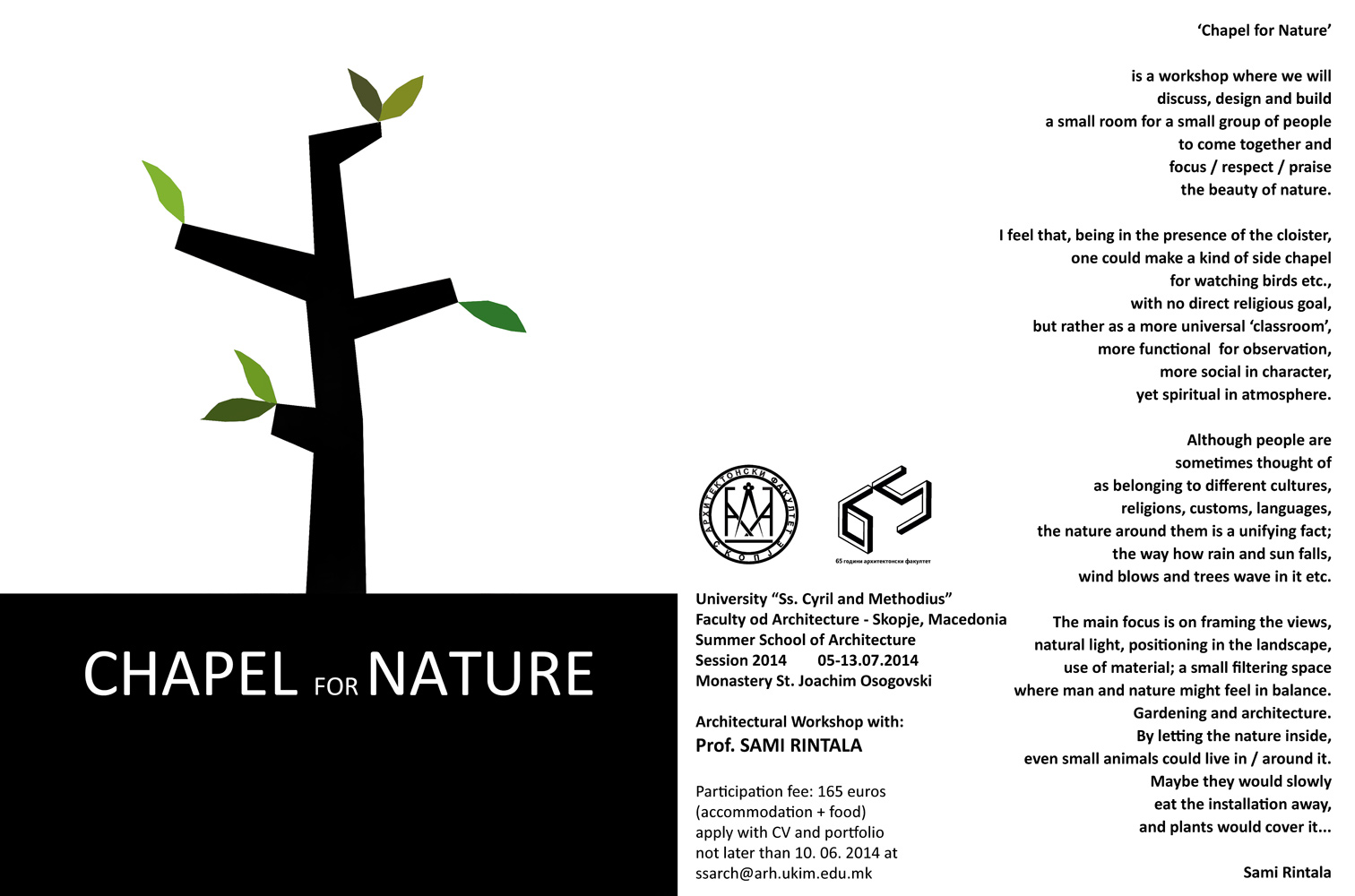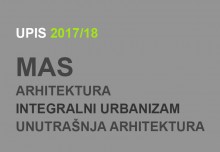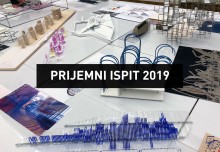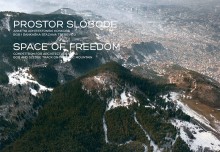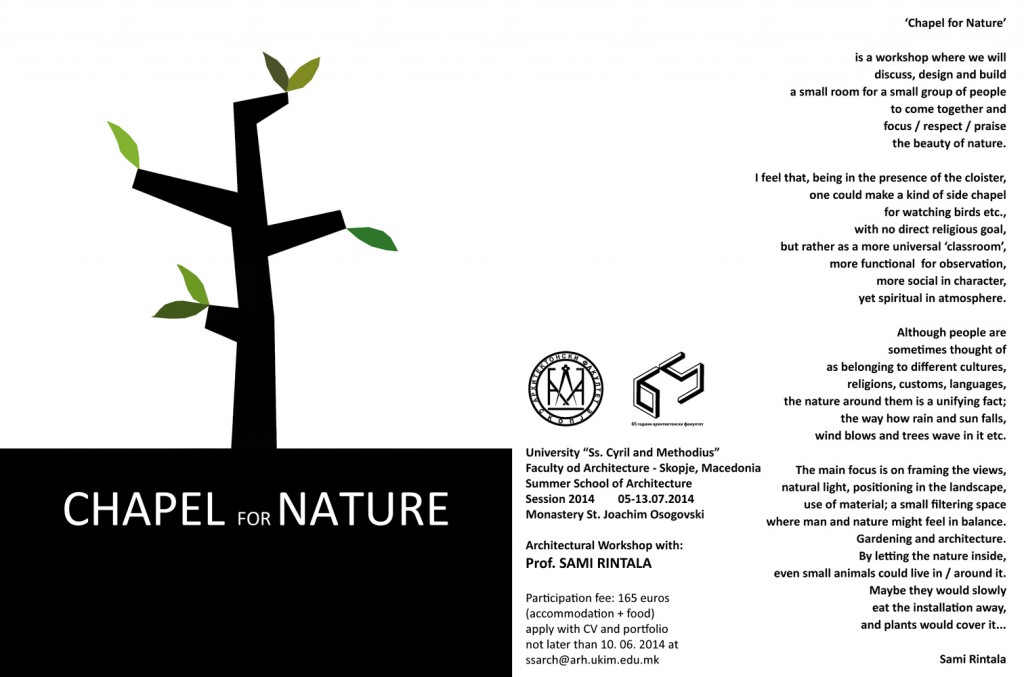Летња школа
Продужено је пријављивање за Летњу школу архитектуре: КАПЕЛА ЗА ПРИРОДУ (CHAPEL FOR NATURE).
Пријаве можете послати и после 10. јуна 2014.
Позив на међународну Летњу школу архитектуре 2014.
23. Летња школа архитектуре
05-13. јул 2014.
Архитектонски факултет „Св. Ћирило и Методије“ Универзитета у Скопљу и ове године традиционално организује међународну Летњу школу архитектуре, која ће се одржати од 5. до 13. јула 2014. године у манастиру „Св. Јоаким Осоговски“ (100 км северо-источно од Скопља).
Тема овогодишње Летње школе је КАПЕЛА ЗА ПРИРОДУ (CHAPEL FOR NATURE). Гостујући предавач радионице Летње школе је проф. Сами Ринтала.
Архитектонски факултет „Св. Ћирило и Методије“ позива све заинтересоване да се пријаве за овогодишњу радионицу Летње школе.
Распоред
05.07.2014.
Долазак учесника у Скопље у јутарњим сатима.
Превоз из Скопља до Криве Паланке пре поднева.
Званично отварање Летње школе архитектуре у вечерњим сатима.
05.07-13.07.2014.
Радионица.
12.07.2014.
Изложба и отварање Капеле за природу.
13.07.2014.
Одлазак учесника и превоз до Скопља.
Пријава
Пријаве се прихватају и после 10.06.2014. а на e-mail адресу ssarch@arh.ukim.edu.mk послати следеће:
- Биографија од максимално 5 страна А4 формата, PDF (са фотографијом и e-mail адресом)
- Портфолио
Изабрани учесници биће обавештени до 15.06.2014. путем e-mail адресе.
Котизација
Котизација за овогодишњу Летњу школу архитектуре износи:
5.000 мкд за студенте Архитектонског факултета у Скопљу;
10.000 мкд (165 евра) за студенте осталих факултета архитектуре.
Котизација укључује радионицу, смештај, храну и превоз на релацији Скопље – Крива Паланка – Скопље. Полазници Летње школе сами плаћају трошкове превоза до Скопља.
Више информација
Више информација о 23. Летњој школи архитектуре можете наћи на следећем линку:
http://ssarch.arh.ukim.edu.mk/
Опис радионице
“Chapel for Nature” is a workshop where we will discuss, design and build a small room for asmall group of people to come together and focus/ respect/ praise the beauty of nature.
I feel that, being in the presence of the cloister, one could make a kind of side chapel forwatching birds etc., with no direct religious goal, but rather as a more universal ‘classroom’, more functional for observation, more social in character, yet spiritual in atmosphere.
Although people are sometimes thought of as belonging to different cultures, religions, customs, languages, the nature around them is a unifying fact; the way how rain and sun falls, wind blows andtrees wave in it etc.
The main focus is on framing the views, natural light, positioning in the landscape, use of material;a small filtering space where man and nature might feel in balance. Gardening and architecture. By letting the nature inside, even small animals could live in / around it. Maybe they would slowly eat the installation away, and plants would cover it…
Sami Rintala

Биографија гостујућег предавача
Sami Rintala (born 1969) is an architect and an artist, with a long merit list after finishing his architect studies in Helsinki Finland 1999. He established architect office “Casagrande & Rintala” 1998, which produced a series of acknowledged architectural installations around the world during the next five years until 2003. These works combine architecture with critical thinking of society, nature and the real tasks of an architect, all within a cross-over art field using space, light, materials and human body as tools of expression.
Rintala had his first wider recognition in 1999 with the project Land(e)scape: Three abandoned wooden barns were raised on 10 meter high legs to follow their farmers to the cities as a critical comment on the deserting process of the countryside. In Venice Biennale 2000 Sixty Minute Man was realized; A ship sailed to Arsenal with a garden inside. The park was planted on sixty minutes of human waste from the city of Venice, becoming together with the old boat a three dimensional collage of society waste commenting on the Biennale theme “less aesthetics, more ethics”.
In 2008, Rintala started a new architect office with Icelandic architect Dagur Eggertsson, called Rintala Eggertsson Architects. The office is based in Oslo, South Norway and Bodø, North Norway.
Important part of Rintala’s work is teaching and lecturing in various art and architecture universities. Teaching takes place usually in form of workshops where the students often are challenged to participate the shaping of human environment on a realistic 1:1 situation.
Sami Rintala’s work is based on narrative and conceptualism. Resulting work is a layered interpretation of the physical, mental and poetic resources of the site.

